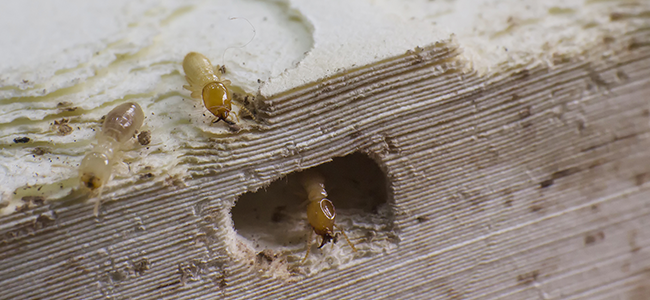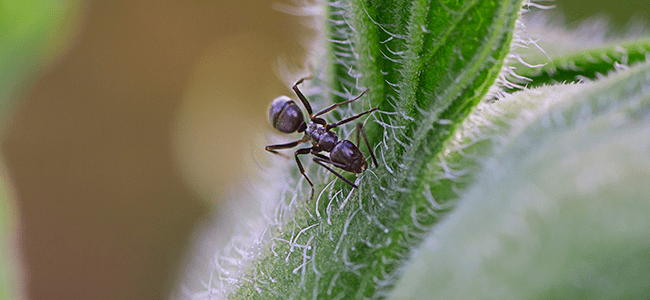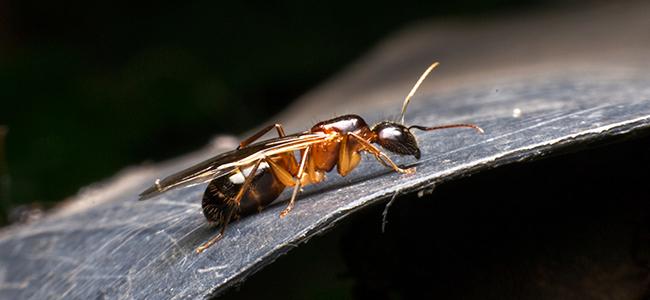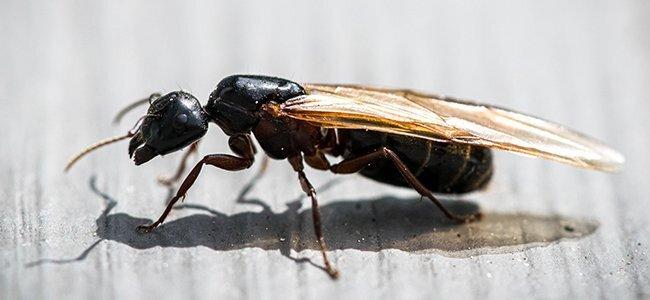
The Best Way To Protect Your Washington D.C. Property From Termites
10/20/2021
What's yellow and white and orange all over? None other than these sneaky insects with a penchant for wooden objects! ...
READ MORE >

If you’ve ever had ants get into your house, you know how annoying it can be. There’s no such thing as seeing just one ant in your house. Once you find that first one, you are sure to find many more. You’ll find them on your floors, climbing your walls, on your countertops, and in your cabinets, among other places.
Because they leave pheromone trails when they enter your house, ants can be difficult to eliminate from your Maryland home. You might squash a few only to find half a dozen more. You can take care of those half dozen only to find that a new batch has moved in right behind them. Understanding how ant infestations start in Maryland homes can help you avoid your own ant infestation.
There are over 10,000 species of ants in the world. They come in many sizes and cause a variety of problems, but thankfully, in Maryland, we don’t have nearly that many species to worry about. In fact, of all the ants in Maryland, there are three that most commonly cause problems for homeowners. Learning a little bit about them can help you if you encounter an ant infestation in your house.
Odorous House Ants
Odorous house ants are tiny ants that can be brown or black. Like all ants, they have segmented bodies, six legs, and a set of elbowed antennae. They enjoy eating sweet foods, especially honeydew.
Odorous house ants move their nests regularly, mainly due to rain. Outside, they nest in soil or firewood. Inside, they nest near a source of moisture, such as hot water pipes or where there is a water leak under the floorboards.
These ants get their name because they give off a foul smell when squished. The scent is similar to rotten coconut, and, although temporary, it is rather unpleasant.
Carpenter Ants
Carpenter ants are the largest of the ants that commonly invade Maryland homes. They can grow larger than half an inch in length and can be red, black, or a combination of the two. Like all ants, they have segmented bodies, six legs, and two antennae that bend at about the halfway mark. Some carpenter ants, specifically the reproductive ones, have wings.
Carpenter ants eat sweet foods. They like honeydew, juice, and nectar, but also eat other insects and will eat other foods, especially if they are in your house and need to eat whatever is available to them.
As their name suggests, carpenter ants nest in wood. They prefer rotting wood, like in tree stumps or among old firewood. When in houses, they’ll nest inside the wooden structures in your house.
Pavement Ants
Pavement ants are slightly larger than odorous house ants, but quite a bit smaller than carpenter ants. They are dark brown or black, have segmented bodies, six legs, and elbowed antennae. Pavement ants are the ants that you most commonly see when you’re outside walking around on your driveway or along the edges of your lawn.
Pavement ants will eat almost anything, from the sweet foods that most ants love to insects, meats, or even cheeses or nuts. They forage for food and typically nest in the cracks of the pavement and under rocks.
Ants can cause a variety of problems for Maryland homeowners. Different ants cause different problems, so the type of ant you have in your house makes a difference when determining what problems you need to look out for.
The good news is that most ants are simply nuisance ants. For instance, pavement ants are considered nuisance ants. They aren’t known to spread any diseases, and they don’t cause damage to your house if they get inside.
However, nuisance ants aren’t completely harmless. The main reason that nuisance ants get into homes is because they are looking for food. If they find what they’re looking for in your cupboards or pantry, they will contaminate whatever food stores they manage to sneak into. Although knowing you won’t catch any harmful diseases from these ants is a relief, you’ll still end up losing a lot of money on wasted food. Not only will you have to throw away the contaminated food, but you’ll also have to replace those items with new items. It turns out that despite their status as “just a nuisance,” these ants will cost you money, time, and frustration.
Like pavement ants, odorous house ants are also considered nuisance ants. However, they have the additional annoyance of smelling bad. Although the unpleasant odor that odorous house ants give off when crushed isn’t anything to worry about, if you have an infestation in your house, you may be smelling that odor quite frequently as you try to get rid of the ants wandering around your house.
Of the three species of ants that most commonly invade Maryland homes, carpenter ants are the ones that are the most dangerous for homeowners. They do not spread diseases, so you don’t have to worry about them making you sick. However, they do damage your house.
Carpenter ants build their nests in wood. When they get into your house, they’ll start chewing tunnels into the wooden elements in your house. At first, this won’t be a big deal, but over time, carpenter ants can do serious damage to the structural elements of your home. As their colony grows, more and more ants can do the work of building tunnels and nests. As more tunnels are built, the wood they chew through becomes weaker and weaker, eventually becoming too weak to hold weight.
Ants get inside Maryland homes for a couple of reasons. Food is, by far, the greatest factor that attracts ants to your house. Ants are foragers and will come inside as they search for food. If they find a good food source, they will continue to return on a steady basis. Oftentimes this is not an indication that they are living inside your house, but simply using it as their main food source.
However, ants can and do nest inside of houses if conditions are right. Most of the time, ants are content to nest in outdoor locations. However, sometimes they may be forced out of their current nesting site and will need to find a new one. Rain is a common factor that drives ants to new nesting areas. Extreme heat or cold can also be a factor.
When ants are forced out of their current nesting area, they may find another outdoor location or they may decide to move into your house. Typically, when nesting inside, ants will look for warm, moist areas, such as near water heaters or leaky pipes. In the case of carpenter ants, they’ll build their nests right within the wood they chew through.
To avoid starting an ant infestation in your Maryland house, you need to get rid of the things that attract ants to your home. As mentioned above, these fall into a couple of main categories: Food and shelter. You can also include water in that list since moisture problems are often a reason that ants stay once they get inside.
In addition to removing attractants, you also need to make sure that your home is difficult to get into. Ants are incredibly tiny and can get into your house by exploiting the smallest of openings. Although it would probably be impossible to seal every entry point accessible to ants, by sealing as many as you can, you can at least make it more difficult for ants to find a way inside.
The following tips will help you avoid an ant infestation.
Do not leave food out on the counter.
Wash dishes immediately after use or put them into the dishwasher right away.
Wash your counters and sweep or vacuum frequently to clean up crumbs and messes.
Store food in hard-sided, airtight containers.
Clean up your pantry and cupboard shelves regularly of any spills or messes.
Take out the trash regularly.
Check for leaky pipes in your house regularly.
Keep moisture levels low in your house with the help of dehumidifiers.
Seal all holes, gaps, cracks, and openings you find around the outside of your house.
Keep outdoor garbage bins tightly closed.
Remove outdoor food sources, such as fallen fruit.
Eliminate areas of excess moisture on your property.
Make sure your outdoor water spigots aren’t drippy.
Despite your best prevention efforts, it’s still possible and even probable, that ants will end up in your Maryland home at some point. Hopefully, the ones that invade are simply nuisance ants and not destructive or dangerous ones, but either way, you’ll want to get them out of your house as quickly as possible.
Unfortunately, this is not always as easy as you’d think it would be. Do-it-yourself methods of ant control have differing levels of success, and if not performed carefully, can actually be quite dangerous. Setting out bait or spraying products around your house can be especially dangerous to young children and pets.
Instead, if ants get into your Maryland home, the safest and most effective course of action is to contact the professionals at American Pest. We are skilled in identifying the source of your ant problem. Instead of simply applying a treatment and hoping it works, we inspect your home to identify what type of ant is inside your house, how it’s getting in, and where it’s coming from. By gathering this information, we’ll know where to target our treatments.
Our ant control is designed not to just treat the symptoms of your ant problem by eliminating the ants you see in your house, but to get to the root of the problem to eliminate the nest. When we find and eliminate the nest, we eliminate the entire colony, which ensures the complete removal of your ant infestation.
For all of your ant control needs, no matter how big or small, you can count on American Pest. We have been serving Maryland and the surrounding areas since 1925 and have seen every kind of pest problem imaginable in that time. We only employ the best pest professionals, and it is one of those who will come to your home, ready to solve your ant problems. Contact us today to schedule an inspection.

10/20/2021
What's yellow and white and orange all over? None other than these sneaky insects with a penchant for wooden objects! ...
READ MORE >

10/01/2021
Fulton, MD, September 30, 2021—American Pest, the leading provider in modern, preventive pest management throughout Maryland, Washington D.C....
READ MORE >

09/03/2021
If ants are making their way around your Washington D.C. home, they can bring a variety of problems to you and your family. However, if it’s ...
READ MORE >

07/21/2021
When ants go on the march, nothing can stand in their way — not even your D.C. property. There are at least 700 different species of ants r...
READ MORE >

Protect your home and family from nuisance and potentially damaging pests with a Preferred Care home pest control plan. Starting at $49/month

Don't let the bed bugs bite a second longer. Contact American Pest for the most comprehensive bed bug control in the industry. Learn More

Our certified rodent control pros will put an end to your frustration by getting rid of rats and mice inside your home. Learn More

Say goodbye to wood-destroying termites in your home when you contact American Pest for expert termite control. Learn More

Trust American Pest to deliver professional backyard tick control services that are guaranteed to get results. Learn More

Don't spend the warm-weather season indoors, find out how American Pest's professional treatments get rid of mosquitoes. Learn More
Fill out the form and recieve feedback in less than 5 minutes. For immediate service please call.